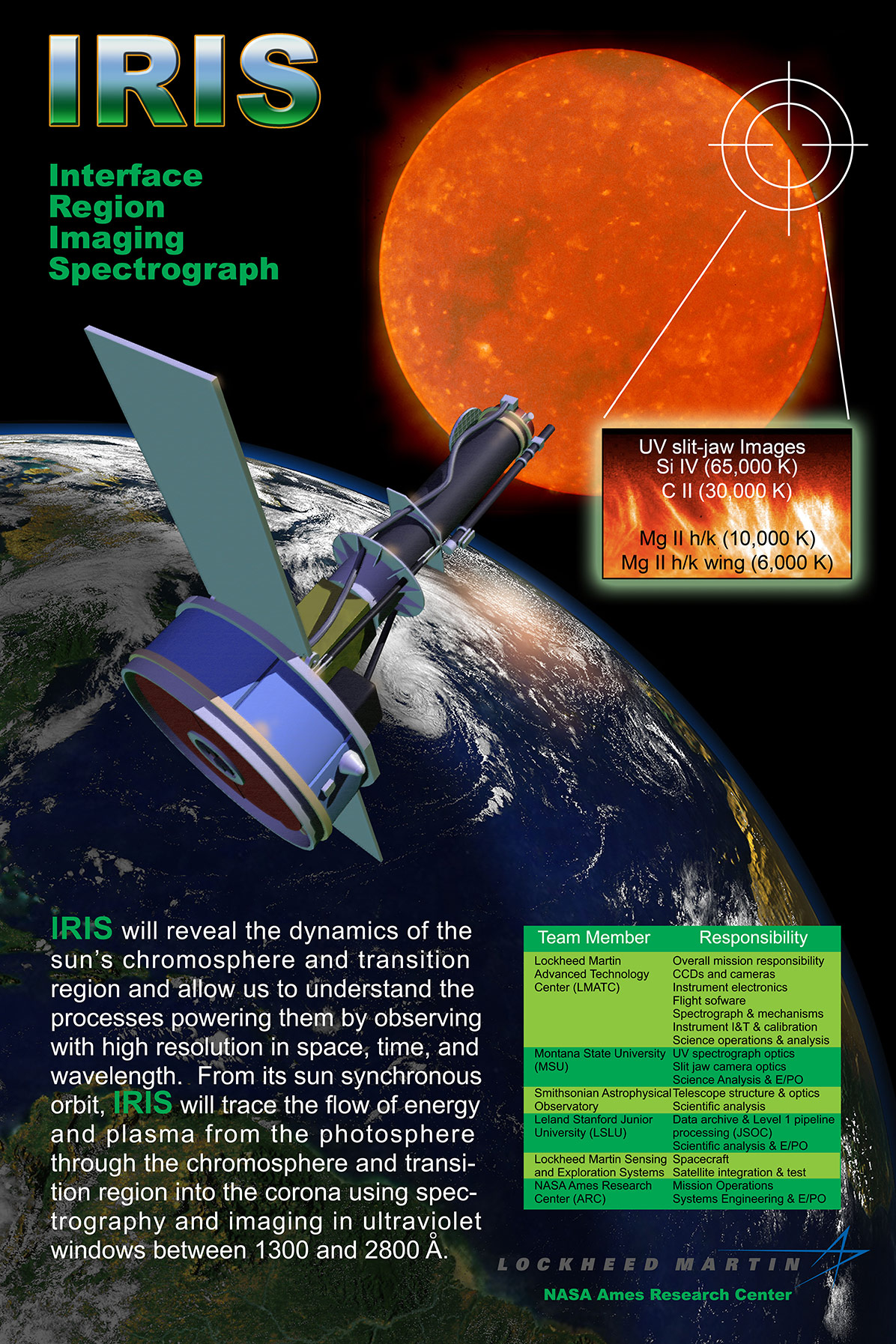IRIS
Interface Region Imaging Spectrograph
IRIS’s primary goal is to understand how heat and energy move through the lower levels of the solar atmosphere.
IRIS will make use of high-resolution images, data and advanced computer models to unravel how matter, light, and energy move from the sun’s 6000 K surface to its million K outer atmosphere or corona. A fundamentally mysterious region that helps drive heat into the corona, this area has been notoriously hard to study. IRIS will be able to tease apart what’s happening there better than has ever been done before.
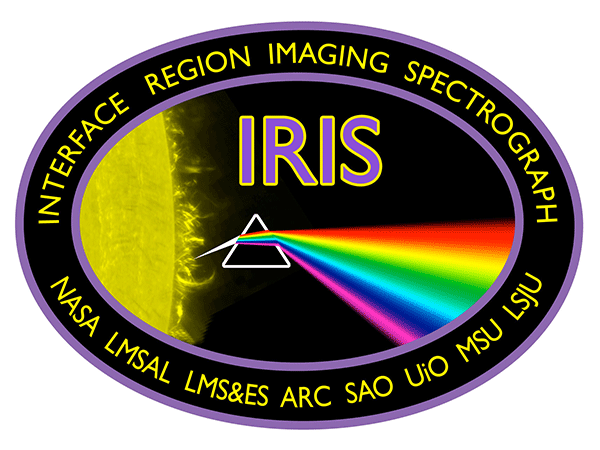
IRIS will observe the lowest part of the sun’s atmosphere: the chromosphere.
The chromosphere is an expanse of ionized gas or plasma lying just above the sun’s surface, and the transition region, where the chromosphere transitions into the even hotter corona above.
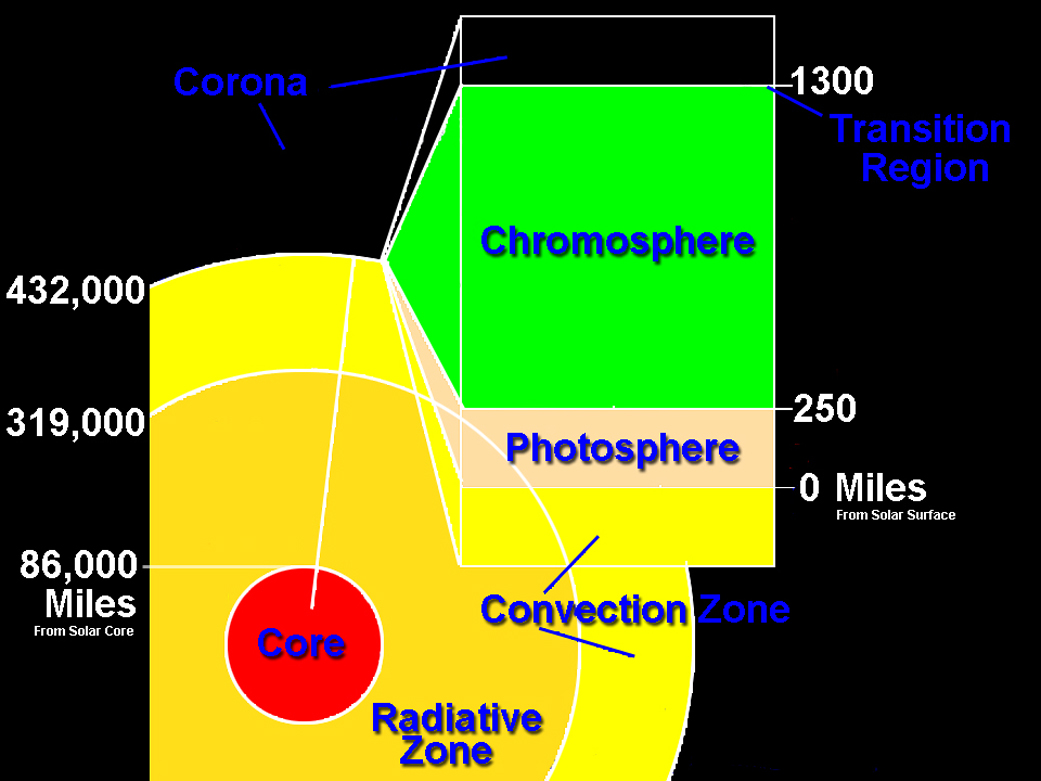
This interface region lies at the core of many outstanding questions about the sun’s atmosphere, such as how the sun creates giant explosions like solar flares or coronal mass ejections (CMEs), or how solar material in the corona reaches millions of degrees, several thousand times hotter than the surface of the sun itself.
Much of this coronal heating begins in the chromosphere and transition region. These highly dynamic regions are constantly in motion, so it isn’t simple to profile temperatures with respect to position. Indeed, a wide range of temperatures can occur at similar heights, with different swaths of material propelled upward and downward in response to the release of magnetic energy, as well as various types of plasma waves. This moving interface region covers a wide range of heights above the sun’s surface, extending over several thousand miles. Throughout this height range, not only do the temperatures vary dramatically from 5000 Kelvin to almost a million degrees, but there are also enormous density contrasts, with certain areas up to a million times more dense than others.
One of IRIS’s main science objectives will be to study how this foundational region of the heliosphere contributes mass and energy to the atmosphere above it, depositing so much heat into the corona.
VIDEO CREDITS: NASA’s Goddard Space Flight Center
Frequently Asked Questions
How big is the IRIS satellite?
IRIS is approximately 7 feet (2.1 meters) long and about 12 feet (3.7 meters) across with its solar panels deployed.
How much does IRIS weigh?
The IRIS observatory weighs 403 pounds.
Where will IRIS launch and what launch vehicle will be used?
IRIS will launch from Vandenberg Air Force Base in Calif. It will be deployed from an Orbital Sciences L-1011 aircraft aboard a Pegasus XL rocket at an altitude of 39,000 feet over the Pacific Ocean about 100 miles Northwest of Vandenberg Air Force Base.
When will IRIS launch?
IRIS is scheduled to launch on June 26, 2013. Deployment from the Pegasus XL rocket is targeted for 7:27 pm PDT in the middle of a five-minute launch window.
How long is the IRIS mission?
Two years.
This image from the joint NASA-Japan Aerospace Exploration Agency’s Hinode mission shows the lower regions of the sun’s atmosphere, the interface region, which a new mission called the Interface Region Imaging Spectrograph, or IRIS, will study in exquisite detail.
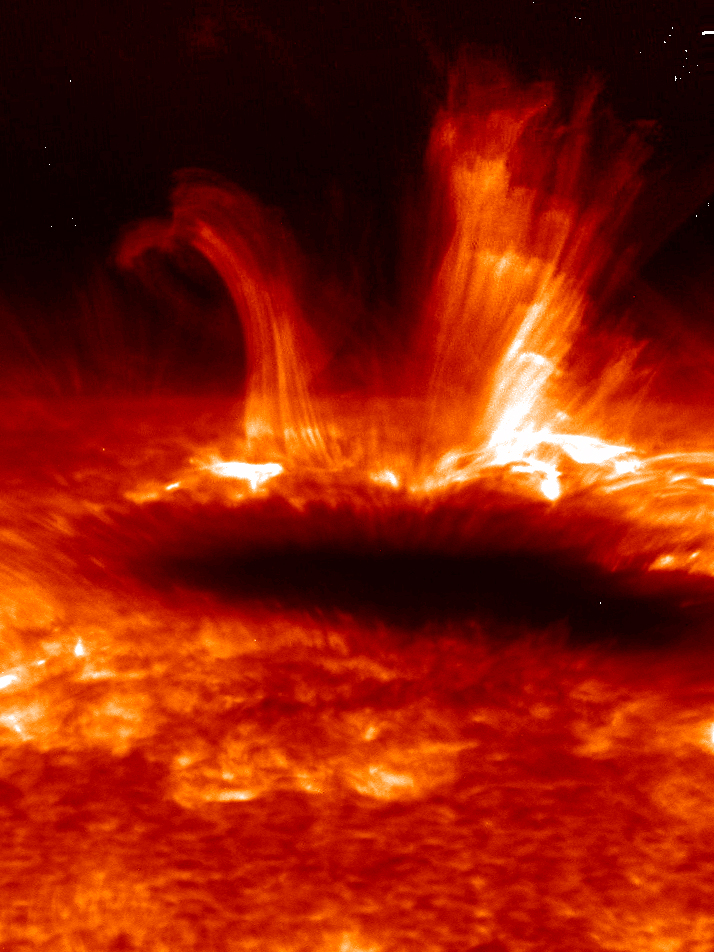
What is IRIS going to study? Why?
IRIS is a NASA Small Explorer Mission that will observe a region that lies between the sun’s 10,000 degree, white-hot, visible surface, the photosphere, and the much hotter multi million-degree outer atmosphere of the sun, the corona. The sun’s dynamically changing chromosphere and transition region make up the key “interface region” that IRIS will study that lies between the photosphere and corona.
IRIS will observe how solar gases move, gather energy, and heat up through the interface region, information that is key to understanding what heats the sun’s corona. IRIS improves our understanding of the interface region where most of the sun’s ultraviolet emission is generated that impacts the near-Earth space environment and Earth’s climate.
All the energy that drives solar activity travels through the interface region and IRIS observations will help our understanding of what causes the ejection of solar material – from the steady stream of the solar wind to larger, explosive eruptions such as coronal mass ejections, or CMEs – that travels toward Earth and causes space weather, which can disrupt human technology.
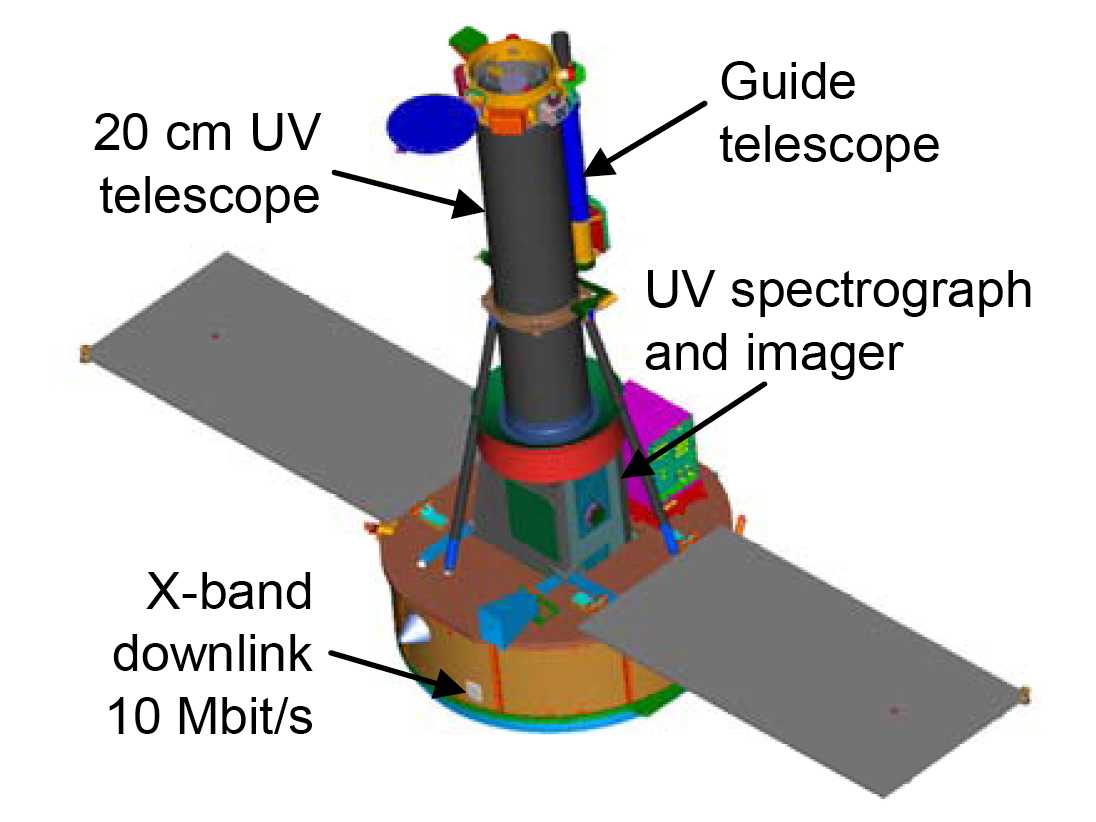
What instrument is on IRIS? What will it study?
IRIS carries a single instrument, an ultraviolet telescope that feeds an imaging spectrograph. The telescope’s primary mirror has a diameter of about eight inches. The images from IRIS’s telescope will record observations of material at specific temperatures, ranging from 5000 K to 65,000 K (and up to 10 million K during solar flares) in order to observe material on the sun’s surface and in the chromosphere and transition region.
The high-resolution images and spectra provided by IRIS will make it possible for scientists to use advanced computer models to unravel how matter, light and energy move fro the sun’s 6,000 Kelvin surface to its million Kelvin corona.
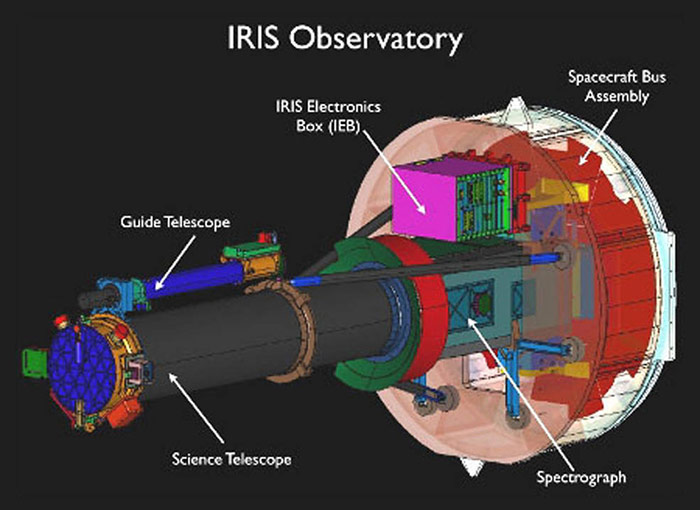
Why can’t NASA just use its existing fleet of solar spacecraft to study this mysterious region on the sun?
IRIS is unique in that it’s the first mission designed to simultaneously observe the range of temperatures specific to the chromosphere and transition region not only at very high resolution, as small as 150 miles across the sun, but also at the quick rate of once every few seconds. Such capability does not exist on other NASA missions.
IRIS will join the Solar Dynamics Observatory (SDO) mission and the joint NASA/JAXA’s Hinode mission. Together they will explore how the solar atmosphere works and impacts Earth, with SDO and Hinode monitoring the solar surface and outer atmosphere and IRIS watching the region in between.
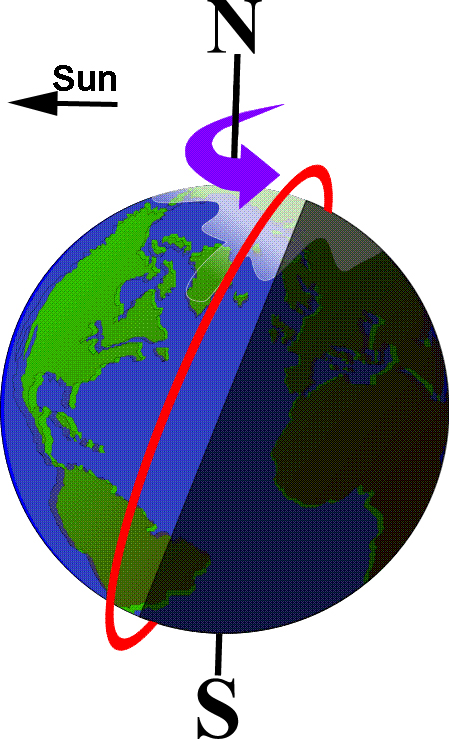
IRIS will travel in a polar, sun-synchronous orbit. This means it will travel around Earth, crossing nearly directly over the poles, in such a way that it crosses the equator at the same local time each day.
What orbit will IRIS operate in and why?
IRIS will travel in a polar, sun-synchronous orbit. This means it will travel around Earth, crossing nearly directly over the poles, in such a way that it crosses the equator at the same local time each day. The spacecraft’s orbit will place it at about 390 miles (620 km) above the Earth’s surface at its closest point, and at 420 miles (670 km) at the farthest. This orbit allows for eight months of continuous observations each year and maximizes eclipse-free viewing of the sun.
How big is the spacecraft?
IRIS is a class of spacecraft called a Small Explorer, which NASA defines as costing less than $120 million. IRIS weighs 440 pounds. It is approximately 7 feet (2.1 meters) long and, with its solar panels extended, is a little over 12 feet (3.7 meters) across.
This video from NASA’s ScienceCast explores the mystery of coronal heating – why the sun’s million-degree upper atmosphere, the corona, is several hundred times hotter than the surface below – and how scientists are using IRIS to address it.
CREDIT: NASA
